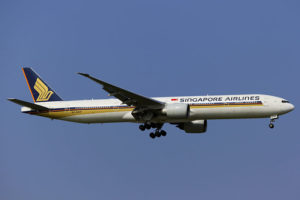
A Singapore Airlines Boeing 777-312(ER)
Photo credit: byeangel (https://tinyurl.com/wusm83hv)
How many airliners would have run out of fuel if it weren’t for the “final reserve fuel” as required by law?
The fuel planning policies by airlines are there for ensuring the safety of each flight. It would include the fuel required for a specific journey, such as the taxi, trip, contingency, alternate, final reserve fuel, fuel for extended diversion time operations (EDTO) for certain flights and the discretionary extra fuel. Among all these, the “final reserve fuel” stands out as a crucial one of the fuel policy.
It is the fuel required to hold (wait) at 1500 feet for 30 minutes in a jetliner at the end of a flight and represents the absolute minimum fuel level that a pilot must avoid falling below.
If the captain anticipates that the estimated time of arrival would lead to fuel levels approaching this critical threshold, he should declare a PAN PAN distress call, which grants him priority and a more direct route for landing.
If the aircraft’s fuel situation becomes even more critical, breaking into the final reserve fuel, the captain must declare a MAYDAY FUEL call, indicating a fuel emergency and the need for immediate priority handling by Air Traffic Control (ATC).
On October 25, 2022, a Boeing 777-300 operating SQ 319, from London to Singapore was diverted from its intended destination, Changi Airport due to bad weather. The aircraft with 280 people on board eventually made an unscheduled landing in Batam, Indonesia, with critically low fuel levels.
An investigation into this incident revealed that the flight crew had initially preferred to land in Changi, despite having the opportunity for an earlier diversion to Batam under better weather conditions. Unfortunately, the weather over Batam later deteriorated, and the pilots, who had already declared a fuel emergency, were compelled to abort their initial approach.
After a harrowing series of attempts, the aircraft finally touched down at Batam Airport. It was noted that the fuel reserves at this point were “significantly” below the final reserve fuel requirement of 3,024 kg – an alarming level as compared to 106,164 kg at departure.
Unlike a car on the ground where an amber or red fuel light typically indicates that the fuel reserves have fallen to about 10-15% of the tank’s capacity, the situation is far more critical in an aircraft.
While you might be able to gauge your car’s remaining mileage and seek out a nearby gas station or a safe spot to await assistance, running out of fuel in an airplane is not an option due to the catastrophic potential outcomes.
So far, no airliner has run out of fuel yet in similar situation except for Avianca Flight 052. The final reserve fuel is designed to prevent such an extremely perilous situation. Therefore, it is important to ensure that every flight should always maintain an adequate fuel reserve to guarantee a safe journey in any weather situation.
Read more on “CAAS flags ‘Shortcomings’ in 2022 incident where SIA jet forced to land in Batam with very low fuel”